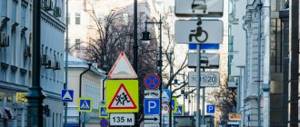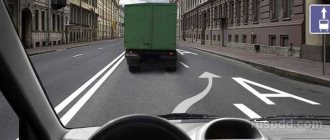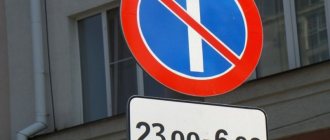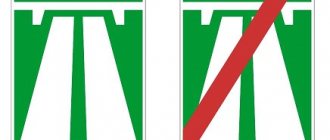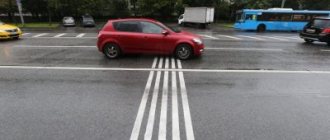Good afternoon, dear reader.
In this article we will talk about traffic signs , which are covered in Appendix 1 “Road Signs” to the traffic rules.
This article is the first article in the “Traffic Signs” series and it examines the most basic features of road signs: the division of signs into groups, the designations of each group, the features of their use.
Types of road signs in 2021
Currently, Appendix 1 to the Traffic Regulations has 8 sections, each of which deals with a separate group of road signs:
- warning signs;
- priority signs;
- prohibition signs;
- prescriptive signs;
- signs of special regulations;
- information signs;
- service marks;
- additional information signs.
Road signs are divided into groups in such a way that each group contains signs that are similar in meaning. Let's look at each type of sign in more detail.
Traffic warning signs
Warning road signs are the most useful and safest signs for a driver. Their safety lies in the fact that the requirements of warning signs cannot be violated , because These signs do not prohibit or restrict the driver. The main function of such signs follows from their name. They warn the driver about possible dangers and help avoid road accidents.
Warning signs are installed on dangerous sections of roads and can be easily distinguished from all other signs. Most warning signs look like a red triangle:
The only exceptions are signs related to railway crossings and “turn direction” signs. Their shape differs from a triangle:
Please note that all other warning signs are triangles .
Let me remind you once again that it is impossible to violate the requirements of warning signs, therefore, in the area of their coverage, a fine for violating the requirements of road signs in the amount of 500 rubles cannot be imposed.
However, warning road signs can warn you against violations that can result in very real penalties.
Consider an example with a “ dangerous turn ” sign:
If you come across a similar sign on the road, then you do not need to take any special action. However, you should keep in mind that after 150 - 300 meters outside a populated area or after 50 - 100 meters in a populated area there will be a dangerous turn on your way.
At a dangerous turn, overtaking is prohibited (clause 11.4 of the rules). Accordingly, for overtaking on a dangerous turn, the driver risks being punished in the form of deprivation of a driver’s license for 4-6 months or a fine of 5,000 rubles.
At the same time, the rules do not prohibit overtaking after the “dangerous turn” sign, but before the start of the most dangerous turn.
More detailed information about warning road signs is provided in the following articles:
Warning signs 1.1 - 1.12 Warning signs 1.13 - 1.23 Warning signs 1.24 - 1.35
Photo and video recording
Changes to traffic rules provide for the introduction of new information signs that will indicate all road surveillance cameras. Now rectangular signs have been replaced by small, inconspicuous signs indicating photo and video recording points.
Outside the city, such a sign should be installed 150-300 meters before the control zone. Inside a populated area, this road sign is installed only at the entrance. It will mark the control zones of both stationary and mobile recording cameras. Once the new rules come into force, the old signs are planned to be removed.
Priority signs
Priority signs, unlike warning signs, establish priority right of passage at intersections, intersections of roadways, and narrow sections of the road.
In this case, you should pay attention that for violating the requirements of priority signs installed at an intersection, you can receive a fine of 1,000 rubles (Part 2 of Article 12.13 of the Administrative Code). For the same violation outside an intersection, a warning or a fine of 500 rubles may be imposed (Part 1 of Article 12.16 of the Administrative Code).
There are only 13 priority signs, so it’s quite easy to remember them even though they all have different shapes and colors.
Priority signs
Addition to 2021 edits
Road signs for which the images have changed
| Number and name | Old look | The new kind |
| 5.35 “Zone with restrictions on the environmental class of motor vehicles” * | ||
| 5.36 “End of the zone with restrictions on the environmental class of motor vehicles” * | ||
| 5.37 “Zone with limited environmental class by type of vehicle” * | ||
| 5.38 “End of the zone with limited environmental class by type of vehicle” * | ||
| 6.4 “Parking (parking space)” | ||
| 7.21 “Gas station with the ability to charge electric vehicles” | ||
| 8.4.3.1 “Type of vehicle” | ||
| 8.4.15 “Except for the type of vehicle” | ||
| 8.9.2 “By parking permits” * | ||
| 8.9.4 “No parking permits” * |
In 2021, new restrictive signs for cars with different environmental classes appeared in the Russian Federation. This year 5 more signs will be introduced. They will restrict the movement of cars and other vehicles in the marked area that do not comply with the environmental class indicated on the sign.
New signs will make it possible to restrict the entry and passage of vehicles with a low environmental class into the marked areas. The new rules also apply to parking; they prohibit drivers from stopping their vehicle if it does not comply with the standards. If previously such signs were valid for cars that had an environmental class specified in their documents, then from 2021 these rules will apply to any vehicle. The rules are already spelled out in the traffic rules. For this violation, a fine of 500 rubles is imposed.
Prohibition road signs
As the title of the section suggests, prohibition signs prohibit the driver from performing certain actions. This section is quite extensive, and it is not always possible to determine their meanings from images of signs. More detailed information about prohibition signs is presented in the following articles:
Prohibitory signs 3.1 - 3.5 Prohibition signs 3.6 - 3.10 Prohibition signs 3.11 - 3.16
Prohibitory signs 3.17 - 3.19 Prohibition signs 3.20 - 3.26 Prohibition signs 3.27 - 3.33
Here I would like to note that most often you can find the following road signs on the road:
| entry prohibited (brick road sign) |
| Movement Prohibition |
| turning is prohibited |
| overtaking is prohibited |
| maximum speed limit |
| stopping is prohibited |
| No parking |
Let's consider an example related to violation of the requirements of a road sign prohibited entry (brick). The punishment for this violation directly depends on which road the driver takes.
If the sign is installed before entering the territory of the organization or the courtyard area, then we are talking about a regular violation of the requirements of road signs (500 rubles).
If a sign prohibits entry onto a one-way road, then a violation will entail a fine of 5,000 rubles or deprivation of rights for a period of 4 to 6 months.
New road signs
Signs prohibiting stopping and parking (3.27d, 3.28d, 3.29d, 3.30d)
Allowed for installation perpendicular to main road signs, including on the walls of buildings and fences. Arrows indicate the boundaries of areas where parking and stopping are prohibited.
Additional stop and no parking signs
Entry to the intersection in case of congestion is prohibited
It is used for additional visual designation of intersections or sections of the roadway on which markings 3.34d are applied, prohibiting driving into a busy intersection and thereby creating obstacles for the movement of vehicles in the transverse direction. The sign is installed before the intersection of roadways.
Entry to the intersection in the event of a traffic jam is prohibited.
The document must contain a description of the sign stipulating the prohibition of entering the intersection. In addition, the sign is an addition to the markings. That is, if there is no marking to determine an offense, you cannot refer to this sign.
Interesting note. Please note: “The sign is installed before crossing roadways.” This arrangement actually equalizes the roadway zones at the intersection and at the intersection of roadways.
Interesting: From April 28, 2021, new road markings and the “Waffle Iron” sign have been added to the Traffic Rules.
Reverse movement
It is used on sections of roads where traffic in directions other than the opposite direction is prohibited.
Movement in the opposite direction
I confess I don’t remember such intersections. If you know such examples, write in the comments or in the VKontakte group.
Dedicated tram lane
To increase the efficiency of trams, it is allowed to install 5.14d signs above the tram tracks while simultaneously separating the tracks with markings 1.1 or 1.2.
Dedicated tram lane
A sign already familiar to us. Installing it is not required. There is currently no sign in the rules. It will probably mean a ban on tram tracks.
Traffic direction signs for public transport (5.14.1d-5.14.3d)
It is used to designate a dedicated lane in front of an intersection in cases where the movement of route vehicles along the dedicated lane in the forward direction is impossible.
Directions for public transport
Direction of movement along the lanes (5.15.1d)
Inform the driver about the permitted directions of movement along the lanes. Free placement of booms is allowed depending on the trajectory and number of directions of movement from the lane. The shape of the lines on the signs must correspond to the road markings. Additional information signs (priority signs, prohibition of entry or through passage, etc.) may be placed on the arrows. In addition to those established by GOST R 52290, it is allowed to use the directions, number and types of arrows, as well as signs in accordance with Figures 6 and 7.
In populated areas, the use of signs 5.15.1d is allowed when the number of traffic lanes is no more than 5 in the direction of the intersection.
Direction of traffic along the lanes
The variations of the signs “Direction of traffic along the lanes” are significantly expanded, which makes it possible to more accurately indicate the traffic pattern at the intersection. The application of images is also quite free. Perhaps even a picture of a tram.
Direction of movement along the lane (5.15.2d)
They inform the driver about the permitted directions of movement in a separate lane. Rules for the use of signs are similar to clause 4.9 of this standard
Direction of traffic along the lane
Brother of the sign “Direction of traffic along the lanes” with the difference that each sign is installed above each lane. This means there is more space for posting information, as well as more responsibility for the organizers of the movement. The absence of even one such sign can create complete confusion at the intersection.
Perhaps we can now begin checking the authors and initiators of the introduction of these new signs. They claim that all signs and images on them are intuitive. Below is a visualization of their use, but for now try to imagine road situations where such signs can be used.
Let's continue.
Beginning of the strip (5.15.3d, 5.15.4d)
Drivers are informed about the appearance of an additional lane(s). It is possible to display additional driving modes and lane assignments for maneuver.
Signs are installed at the beginning of the stretch of the beginning lane or at the beginning of the transition marking line. Signs may also be used to indicate the start of a new lane when a dedicated lane ends.
Beginning of the lane
Often, when organizing traffic, special additional lanes are installed, intended only for turning or turning. Now such information is available to the driver immediately when a new lane appears on the roadway.
End of strip (5.15.5d, 5.15.6d)
They inform the driver about the end of the lane, visually highlighting the priority. Signs are installed at the beginning of the strip of the ending strip or at the beginning of the transition marking line.
End of Lane The
“End of Lane” sign has undergone only visual changes, where changing lanes into the adjacent lane is more clearly expressed and which clearly indicates the priority of movement along the lane that has an extension.
Changing lanes onto a parallel roadway (5.15.7d, 5.15.8d, 5.15.9d)
Inform drivers about traffic priorities when changing lanes onto a parallel roadway. Used in addition to the main priority signs 2.1 and 2.4.
Changing lanes onto a parallel roadway
The new signs really do not require any comment. Please note that a median does not necessarily separate oncoming traffic.
End of the parallel carriageway (5.15.10d, 5.15.11d)
Inform drivers about traffic priorities when merging parallel roadways. Used in addition to the main priority signs 2.1 and 2.4.
End of a parallel carriageway
Another additional priority indicator when adjacent carriageways merge.
Combined stop sign and route indicator (5.16d)
For the convenience of public transport passengers, a combined stop sign and route indicator can be used.
Illumination at night is recommended.
Combined stop and route sign
Pedestrian crossing (5.19.1d, 5.19.2d)
Installation of additional attention frames is allowed only around signs 5.19.1d, 5.19.2d at unregulated pedestrian crossings and at crossings located in places without artificial lighting or limited visibility.
It is recommended to install frames whose width is proportional to the size of the sign and is no more than 15% of the width and height of the standard size used.
Pedestrian crossing
In an effort to attract attention to pedestrian crossings, road signs began to be thoughtlessly framed with reflective frames, so that road signs began to look like billboards. Now the sizes of frames and places of their use are regulated.
Diagonal pedestrian crossing (5.19.3d, 5.19.4d)
Used to designate intersections where pedestrians are allowed to cross diagonally. Sign 5.19.3d is installed in front of a diagonal pedestrian crossing and replaces signs 5.19.1d, 5.19.2d. An information sign is installed under the pedestrian section.
Pedestrian crossing
For more than two years, diagonal pedestrian crossings have been prescribed in the Traffic Rules, and now the designation of such crossings has also appeared.
Yield to everyone, and you can turn right (5.35d)
Allows right turns regardless of traffic lights, provided that priority is given to other road users. It is installed on the traffic light on the right side at the level of the red and yellow signals. The width of the sign is equal to the width of the section, and the height is equal to the height of two sections of the corresponding traffic light. Can be used outside areas with heavy traffic of pedestrians and/or cyclists.
Yield to everyone, and you can turn right.
One of the debatable issues. According to the authors of the experiment, not a single accident was recorded at intersections where such a sign was used and a right turn on a red traffic light was allowed. And now a new road sign has made its way into the standard. We are expecting amendments to the Traffic Rules.
Driving directions at the next intersection (5.36d)
Indicates the direction of movement along the lanes of the next intersection. The use of these signs is allowed if the distance to the next intersection is no more than 200 meters, and the specialization of the lanes at it differs from the intersection at which these signs are installed. Signs are allowed to be installed only above the main signs 5.15.2 “Direction of traffic along lanes”.
Directions at the next intersection
Another controversial new road sign. On the one hand, there is additional information, on the other hand, is there too much of it? Eight road signs in one plane, not counting traffic lights.
Bicycle and pedestrian zone (5.37d)
Used to designate an area (section of the road) where only pedestrians and cyclists are allowed to move in cases where pedestrians and cyclists are not separated into separate flows. The sign is installed in places where vehicles can enter.
Bicycle and pedestrian zone
End of the bicycle and pedestrian zone (5.38d)
Installed at all exits from the territory (section of the road) marked with sign 5.37 “Bicycle-pedestrian zone”. It is allowed to be placed on the reverse side of the sign 5.37. The sign is installed in places where vehicles can enter.
End of the bicycle/pedestrian zone
Paid parking (6.4.1d, 6.4.2d)
Used to designate a paid parking zone. Both options are acceptable.
Paid parking
Off-street parking (6.4.3d, 6.4.4d)
Used to designate off-street underground or above-ground parking.
Off-street parking
4.24 Parking with the method of placing the vehicle (6.4.5d – 6.4.16d)
Signs are formed by placing on the field of sign 6.4 “Parking (parking space)” elements of signs and other signs of additional information characterizing the specialization of parking, in order to save space and materials.
Parking with a method of parking a vehicle
Let’s note the new method of parking a vehicle in a “Herringbone” pattern or at an angle to the edge of the roadway. Previously, this method could only be implemented using markup.
Parking for disabled people (6.4.17d)
Parking with a vehicle staging method
Direction of parking placement (6.4.18d – 6.4.20d)
Allowed for installation perpendicular to main road signs, including on the walls of buildings and fences. Arrows indicate the boundaries of zones where parking is organized.
Direction of parking
Indication of the number of parking spaces (6.4.21d, 6.4.22d)
The number of parking spaces is indicated. Both options are acceptable.
Indication of the number of parking spaces
Type of vehicle (8.4.15d)
Extends the effect of the sign to excursion buses intended for the transport of tourists. The plate in combination with sign 6.4 “Parking (parking space)” is used to highlight specialized parking in tourist-attractive places.
Type of vehicle
Months (8.5.8d)
The plate is used to indicate the period of validity of the sign in months for signs whose validity is seasonal.
Months
Time limit (8.9.2d)
Limits the maximum permissible parking time. Installed under signs 3.28-3.30. Any required time may be specified.
Time limit
Width limitation (8.25d)
Indicates the maximum permissible vehicle width. The sign is installed under sign 6.4 “Parking (parking space)” in cases where the width of parking spaces is less than 2.25 m.
Width limitation
Deaf pedestrians (8.26d)
The plate is used in conjunction with signs 1.22, 5.19.1, 5.19.2 “Pedestrian crossing” in places where people with hearing impairments are likely to appear.
Deaf pedestrians
Mandatory signs
Mandatory road signs are the opposite of the prohibitory signs discussed above. Mandatory signs allow only certain road users to perform certain actions.
For example, a road sign “bicycle path” allows only cyclists:
Various fines may be imposed for violating the requirements of mandatory signs.
For example, for driving onto a pedestrian path, the driver will receive a fine of 2,000 rubles (Part 2 of Article 12.15 of the Administrative Code).
Mandatory signs 4.1 - 4.2 Mandatory signs 4.3 - 4.8
Signs of special regulations
Signs of special regulations combine elements of both prohibitory and prescriptive signs.
For example, sign 5.19.1 “pedestrian crossing” allows pedestrians to cross the roadway, and sign “maximum speed limit zone” prohibits speeding on a selected section of the road.
Penalties for violating the requirements of special regulations signs depend on the type of sign and can vary widely.
Signs of special regulations 5.1 - 5.7 Signs of special regulations 5.8 - 5.14 Signs of special regulations 5.15
Signs of special regulations 5.16 - 5.20 Signs of special regulations 5.21 - 5.26 Signs of special regulations 5.27 - 5.34
Additional information signs (plates)
Additional information signs serve to clarify the meanings of road signs from other sections.
For example, a “wet surface” sign indicates that the sign applies only to the period of time when the road surface is wet.
The above combination of signs means that overtaking on the road is prohibited only when the surface is wet.
There are no separate fines for violating the requirements of Section 8 signs. In this case, the type of punishment is determined by the sign, which is the main one and is located above the sign.
Plates 8.1 - 8.2Plates 8.3 - 8.5.3Plates 8.5.4 - 8.9
Plates 8.10 - 8.16Plates 8.17 - 8.22.3
Road sign numbers have also been changed
Changes in the numbering of road signs. Be carefull!
| Image | Old number | New number (Change No. 3) | Image | Old number | New number (Change No. 3) |
| 5.14 | 5.14.1 | 5.14.1 | 5.14.3 | ||
| 5.36 | 5.37 | 5.37 | 5.36 | ||
| 7.14 | 7.14.2 | ||||
| 8.9 | 8.9.1 | 8.4.3 | 8.4.3.2 | ||
| 8.9.2 | 8.9.4 | 8.9.1 | 8.9.2 |
Despite the minor changes in the rules, it is better to familiarize yourself with them in advance. This will avoid fines for violations.
In our store you can purchase high-quality road signs that meet all GOST standards.
